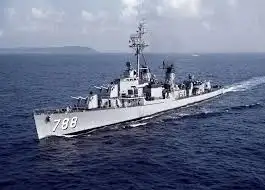The USS Hollister (DD-788) was a Gearing-class destroyer that had multiple Far East deployments between its launch in 1945 and being decommissioned in 1979. The ship’s record included a long record of service in the Korean and Viet Nam wars, as well as peacetime training and fleet exercises operated out of its home port in San Diego, California. Like many other Navy ships constructed during that time, the USS Hollister was built using a significant amount of asbestos and asbestos-containing materials. Many of the veterans who served aboard the ship, as well as the shipyard workers involved in building the vessel, were later diagnosed with malignant mesothelioma, asbestosis, and other asbestos-related illnesses, and others are still at risk.

About the USS Hollister
The USS Hollister was one of 98 of the last destroyers commissioned during World War II. The Gearing class ships were an improvement over the Allen M. Sumner class, with their hulls lengthened by 14 feet to increase fuel capacity and extend operating range, as well as to accommodate better internal subdivision. Though 152 were ordered, only 98 were completed. The Gearings underwent numerous conversions and upgrades to ready them for specific battles, including anti-submarine warfare modifications and the addition of radar pickets.[1]
The USS Hollister played numerous war and peacetime roles. In 1946, her crew helped the Korean government with anti-smuggling activities and engaged in peacekeeping operations in the western Pacific as part of the 7th Fleet. The ship was among the first reinforcements sent to halt North Korean aggression against South Korea, taking part in the successful landing at Inchon as part of Task Force 77. It later patrolled the shores of Korea and Formosa.
The USS Hollister was active in numerous antisubmarine exercises with the Philippine Navy and underwent FRAM (Fleet Rehabilitation and Modernization) and the addition of a helicopter deck and hangar aft.[2] Notably, it was the first U.S. Navy vessel to ever fire a Surface-to-Surface missile in combat following having received more than 250 rounds of hostile fire the day before. The resulting battle destroyed a large cache of ammunition and a North Vietnam Radar site and has been described as the most daring Destroyer operation of the Vietnam War.
The Hollister was 390 feet long and 41 feet wide and was capable of speeds over thirty knots. Its propulsion came from four Babcock & Wilcox or Foster Wheeler boilers and two General Electric geared steam turbines, all of which contained asbestos components that have been blamed for numerous cases of asbestos exposure in Navy veterans.
The Hollister displaced 3,460 tons and held a complement of 336 officers and enlisted men, serving as home to thousands of service members over the years.[3]
Construction and Repairs
The USS Hollister was first launched in October of 1945 and was officially commissioned on March 19, 1946, when it sailed under the leadership of Commander William T. Samuels. The ship was built by Todd Shipyard in Seattle and sponsored by Mrs. Howard J. Hollister. The ship was named for her three sons, who were killed while serving in the U.S. Navy in World War II.
The ship underwent MK1 Conversion at the Puget Sound Shipyard in Bremerton, Washington, as part of the Fleet Rehabilitation and Modernization program, having a helicopter pad and hangar aft added and undergoing repairs.
The ship was struck from the Navy inventory in August 1979 and transferred to Taiwan in 1983, where it served the Republic of China’s Navy until it was decommissioned in June 2004. After undergoing disassembly for usable materials, she served as a target ship for naval and air force training. She was later towed out to sea and sunk as an artificial reef.
Service and Deployment History of the USS Hollister
The USS Hollister began its service operating out of San Diego, California, where it participated in peacetime training and fleet exercises. In 1950, the Hollister joined the U.S. Seventh Fleet to operate out of Sasebo, Japan, with the Fast Carrier Task Force as part of the forces sent in response to North Korea’s invasion of South Korea. Crew members rescued downed pilots, screed for submarines, and participated in plane guard duty. The ship and other units of Destroyer Division 112 and the cruiser USS Manchester bombed an area where North Korean Communists were building entrenchments and helped with the evacuation of Allied Forces from the Hungnam Beach Head as well as the evacuation of the Tachen Islands in 1955. The military actions that the ship participated in off of Japan and the South China Sea were considered by some “the most forthright U.S. action against communism since the Korean War.” [3]
The ship participated in antisubmarine exercises off of the American West Coast and was deployed with the 7th Fleet after the Lao crisis, remaining there until 1962. In 1964, she left California again with an antisubmarine group, headed to Japan as part of contingency operations in the South China Sea. While there, she received the Armed Forces Expeditionary Medal for her patrol services off the shore of Vietnam.
After a three-month overhaul in 1965, the ship was deployed again to the western Pacific for Taiwan Patrol duty to guard planes in the Tonkin Gulf. During a thirty-month tour from 1966 to 1968, the Hollister was ordered to patrol the North Vietnamese coastline from the Demilitarized Zone north and to destroy all North Vietnamese water-born logistics craft carrying arms and materials, as well as destroying selected enemy military targets onshore.
After another in-depth overhaul in 1972, the Hollister left for her eighteen deployments to the Western Pacific, carrying a new missile configuration. The ship was the first U.S. Naval Vessel to ever fire a Surface-to-Surface missile in combat after having come under 250 rounds of fire. The missiles silenced a North Vietnam Radar site and destroyed a huge ammunition cache, returning 193 rounds of fire on the island of Hon Me. The operation was considered the most daring involving a Destroyer of the Vietnam War. The ship’s final return from the Western Pacific was in 1973. In total, the ship completed 21 Western Pacific deployments and action in two major conflicts.
How Was Asbestos Used on the USS Hollister?
The widespread use of asbestos on the USS Hollister was typical of ships built between the 1930s and 1980s, particularly during the years surrounding World War II. The material was valued because it was capable of insulating and fireproofing without adding significant weight. Asbestos was inexpensive and accessible, and though many of the companies providing the asbestos were aware of its health risks, the military was not and favored it for its ability to protect both service members and military assets.
Onboard ships, asbestos was utilized in numerous applications, including:
- Engine and Boiler Rooms: These areas represented the most significant use of asbestos on ships. The material was used to insulate equipment and help prevent the spread of fire.
- Protective Gear: Asbestos was incorporated into gear worn by sailors to protect them from burns, as well as firefighting equipment.
- Pipe Insulation: Asbestos was used to insulate pipes running throughout the ship.
- Additional Components: Ship elements, such as gaskets, valves, and flooring materials, all contained asbestos.
Who Was Exposed to Asbestos on the USS Hollister?
Those who served aboard the USS Hollister faced significant risks of asbestos exposure. The material was present throughout the ship, and any disturbance to asbestos-containing materials could release microscopic fibers into the air, which were easily inhaled or ingested. Once inhaled, these needle-edged givers were difficult for the body to expel and, over time, caused tissue death or damage that led to scarring, mutations, and serious illnesses, including mesothelioma, which often appear decades later.
While everyone on board was at risk of exposure, the crew members who worked directly with asbestos-containing materials in tight areas with poor ventilation faced the greatest risks. This included any repair and maintenance workers who handled asbestos-coated pipes and the men stationed in the engine and boiler rooms.
There have been mesothelioma lawsuits filed by Navy veterans who served aboard the USS Hollister, including William Ankiel, Jr., who was stationed aboard the ship from October 1975 to 1978. Tasked with operating boilers in the fire rooms, repairing equipment including valves, pumps, and boilers, and cleaning machinery spaces, he suffered significant exposure to the toxic material. After his death, his family filed claims against the manufacturers of the equipment that was installed on the ship. The family’s claim was supported by testimony from a shipmate, as well as expert witness testimony from naval experts and medical experts.
Benefits and Compensation Available for USS Hollister Veterans
If you are a Navy veteran who served on the USS Hollister, or if you worked on the ship in any of the shipyards where it was repaired and upgraded, you may have been exposed to asbestos and put at risk for serious illnesses. Veterans who were exposed to asbestos and sickened by that exposure have the right to seek compensation from the Department of Veterans Administration.
Filing a claim with the Veterans Administration (VA) may lead to receiving benefits, including coverage for medical expenses and access to medical care at either a VA medical center or any specialized treatment center specializing in your illness. VA benefits also include disability compensation, with mesothelioma rated as 100% disabling.
In addition to receiving help from the VA, veterans are also able to seek compensation from the many asbestos companies that supplied the toxic material to the military. These companies can be pursued through lawsuits, which may result in jury awards or settlements. There are also many asbestos that were forced into bankruptcy by their asbestos liabilities and, as part of that process, were required to establish asbestos trust funds for the benefit of victims.
If you were exposed to asbestos on the USS Hollister or during any military service, your best source of information is an experienced mesothelioma lawyer. They can answer your questions, explain the process, help you identify the asbestos companies responsible for your illness based on your time of service, and help you file for VA benefits as well as a lawsuit.
References
- Destroyer History. (N.D.) Gearing Class.
Retrieved from: https://destroyerhistory.org/sumner-gearingclass/gearingclass/ - Naval History and Heritage Command. (N.D.). USS Hollister (DD-788)
Retrieved from: https://www.history.navy.mil/our-collections/photography/us-navy-ships/alphabetical-listing/h/uss-hollister–dd-788-0.html - USS Hollister History. (N.D.). The USS Hollister DD778
Retrieved from: https://www.usshollister.org/history.html#:~:text=HOLLISTER%20was%20first%20launched%20to,out%20of%20San%20Diego%2C%20CA.

Terri Heimann Oppenheimer
WriterTerri Oppenheimer has been writing about mesothelioma and asbestos topics for over ten years. She has a degree in English from the College of William and Mary. Terri’s experience as the head writer of our Mesothelioma.net news blog gives her a wealth of knowledge which she brings to all Mesothelioma.net articles she authors.

Dave Foster
Page EditorDave has been a mesothelioma Patient Advocate for over 10 years. He consistently attends all major national and international mesothelioma meetings. In doing so, he is able to stay on top of the latest treatments, clinical trials, and research results. He also personally meets with mesothelioma patients and their families and connects them with the best medical specialists and legal representatives available.


